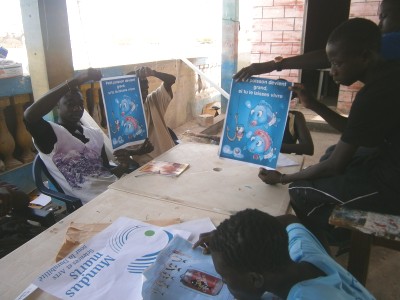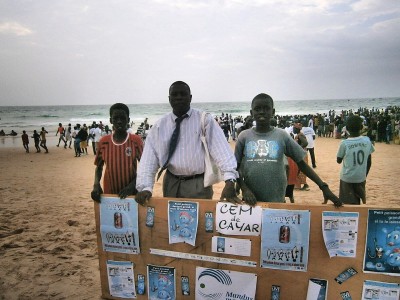by Abibou Diop, Principal of the CEM in Kayar

The Mid-level School (Collège d'enseignement moyen, CEM) in Kayar is a public educational institution created in 2006. Located in the municipality of Kayar, an important town mostly inhabited by fishermen and vegetable growers. The school conducts teaching activities of artistic expression and awareness focused on the protection marine ecosystems for the promotion of sustainable and responsible fisheries, since its inception and lately through meeting with Mr Aliou SALL, a social anthropologist who has a solid experience in supporting and the empowerment of traditional fishermen of the West African sub-region. The pupils are in the age group of 11-18 years. We animate intense educational youth work around these issues and also engage internationally, including through our participation in the exhibition at the European School in Brussels and another one in conjunction with the MARE Conference of the People of the Sea, Amsterdam, in 2009. Click here for our profile.
The same enthusiasm and the same dynamics are maintained by the school in our active participation in pilot activities of Mundus maris in collaboration with FAO - EAF Nansen Project to test and introduce the ecosystem approach to fisheries into the curriculum.
The Mundus maris Club of the CEM has twelve (12) girls aged between 13 and 16 years and 16 boys aged 11 to 18 years. Supervision is provided by a teacher in Life and Earth Sciences. This group has the full support of the Principal of the School, as well as the collaboration of the Department of Fisheries and the Marine Protected Area Kayar (MPA), among others. The club has even a few former pupils as members who now study at the Lycée.
In response to the appeal to find names for the Mundus maris mascots, the Club did a lot of work about the subject of overfishing in order to make suggestions for the names, answer questions and concerns about what that means for the future of the industry. The Club has accounted for the local culture and tradition and involved the administrative and technical fisheries and oceanography services, the managers of the Marine Protected Area and some sages of the fishing community.

As a result of this analysis, the Club members could better understand the local situation, which species to choose, to raise awareness on the socio-economic impact of overfishing in the area and propose concrete measures to deal with the dangers arising from overfishing and ecosystem degradation.
We therefore chose to represent the mascots as Sardinellas, a pelagic species of economic and sociological importance. It is still abundant and popular also among the socially disadvantaged. It fits very well the Senegalese taste for food and cooking, especially the national dish with rice and fish.
We propose the following names: SAMBA for the male and KUMBA for the female.
Sardinella SAMBA is the name typically given in Senegalese tradition to the second child of a household. The name is assimilated to that of the Prophet of Islam, a great traveler and migrant to spread the word, and to that of the West African trader, peddler or carrier of goods - so the image of sardinella as a migratory species par excellence is most fitting. In a different vein, Samba also evokes the world famous dance from Brazil or Latin America.
Sardinella KUMBA is the name that the Club chose for the mascot girl. In Senegal a natural girl in all states (from virtues and blunders) is called Kumba. Fairly close yet distinct from Samba, she embodies his natural partner. Phonetically the name recalls the dance Rumba, another variant of restless, syncopated dance to the image of the sardinella and the contortions of multiple movements.
In Senegal, Samba and Kumba are the natural couple, partners in various adventures. They embody and symbolize the common man, the ordinary, just as sardinellas transcends social cleavage and barriers.
In our tales and legends, Samba and Kumba are homeless, migrants like the prophet who guarantees the profusion and abundance, but Kumba also evokes the image of a pregnant woman, heavy and dragging. Can we not already see the hunt for the species, which decimated the stock through overfishing?
Economically and sociologically, the two Sardinella species, the round and flat sardinella, cross many sectors. Ecologically they play an important role as food for bigger carnivorous species in the ecosystem and their rapid reproduction make them relatively resilient to heavy fishing. November to June are the best season for fishing Sardinellas in Senegal. During that period, Kayar hosts large numbers of migrant and seasonal workers together with the largest increase in the canoe fleet. The pressure on resources is a significant factor in overfishing, aggravated by use of nets with too small mesh sizes, which catch sardinellas before they have had a chance to reproduce at a size equal or bigger than 12 cm total length.

A battery of measures if applied with rigor and firmness can help cope with overfishing and avoid scarcity of Sardinella. In addition to the quota applied by local authorities to licenses all fishing authorizations issued to foreign shipowners should be withdrawn or not renewed. The local fishing industry has sufficient capacity to exploit the resource for the local and the international markets. The local fishing communities in Senegal are taking bold initiatives in the major landing sites: in Kayar, Mbour, Joal and St Louis women fish processors refuse to buy immature fish for processing. They want a minimum length of Sardinellas of 15 or 17 cm as a precautionary measure.
Reduce or control the ease of access to the resource requires a binding action on fishing costs and methods: e.g. by increasing the cost of the license or permit and by ensuring the 28 mm stretched mesh size for nets and 50 mm mesh size for seines.
Protecting the Sardinella from overfishing and ensuring its continued abundance in our waters will have multiple positive effects, foremost by increasing food security, but also safeguarding jobs, particularly female jobs in the processing industry. Reigning in the overfishing would also be positive for economic and financial benfits.
Last but not least, we in the education system are ready to support a much needed change of attitude and a new approach to the perception of the maritime economy that recognises the urgency of restoring coastal zones and oceans to a healthy state. Hence the relevance of Mundus maris efforts for the integration of the ecosystems approach to fisheries and maritime activities into ordinary education.
Click here to read the incredible story of Sardinella Samba and Kumba narrated by the Mundus maris Club of the CEM in Kayar. Watch the video animation of the story by Michael Yap here.









